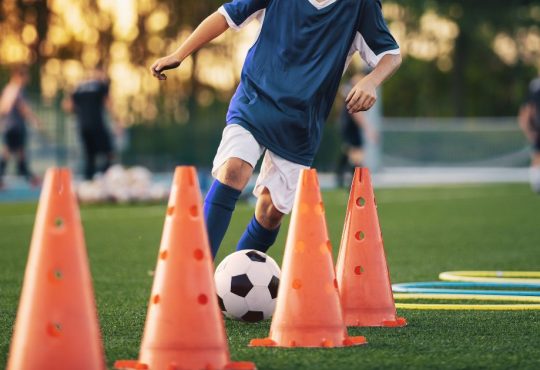Soccer, the beautiful game, is enjoyed by millions of people around the world. Whether you’re inspired by watching professional players or simply looking for a fun way to stay active, starting to play soccer can be an incredibly rewarding experience. But where do you begin? This guide will walk you through everything you need to know to get started, from understanding the basic rules to finding the right gear and honing your skills on the field.
Introduction to Soccer: Why Play?
Soccer is more than just a sport; it’s a way to connect with others, stay fit, and challenge yourself both physically and mentally. The simplicity of the game—where all you need is a ball and some space—makes it accessible to everyone, regardless of age or skill level. Playing soccer can help improve your cardiovascular health, coordination, and agility, while also teaching valuable life skills such as teamwork, discipline, and perseverance.
Starting to play soccer might seem daunting at first, especially if you’re unfamiliar with the game’s nuances. However, with a bit of guidance and practice, anyone can learn to enjoy and excel in soccer. In this article, we’ll cover the essentials to get you on the field with confidence, including the basic rules, essential equipment, and fundamental skills.
Understanding the Basics
1. Know the Rules
Before you hit the field, it’s important to understand the basic rules of soccer. Here are the key points to get you started:
- Objective: The main goal in soccer is to score more goals than the opposing team by getting the ball into their net. Each goal counts as one point.
- Players: A standard soccer team has 11 players, including one goalkeeper. However, for casual play, teams can be smaller. The outfield players include defenders, midfielders, and forwards, each with specific roles.
- Field: Soccer is played on a rectangular field with goals at each end. The size of the field can vary, but for official matches, it is typically about 100-130 yards long and 50-100 yards wide. The field includes key areas like the penalty area, goal area, and center circle.
- Duration: A standard match is divided into two 45-minute halves with a 15-minute halftime break. If the game is tied and a winner must be determined, extra time and penalty shootouts may be used.
- Scoring: A goal is scored when the entire ball crosses the goal line between the goalposts and beneath the crossbar. The team with the most goals at the end of the match wins.
- Fouls: Physical contact is part of the game, but there are rules against certain types of contact, such as tripping, pushing, or handling the ball (except by the goalkeeper within their penalty area). Fouls result in free kicks, and more severe infractions can lead to yellow or red cards.
- Offside Rule: A player is offside if they are nearer to the opponent’s goal line than both the ball and the second-last opponent when the ball is played to them, unless they are in their own half or level with the second-last opponent.
2. Get the Right Gear
Having the proper equipment is crucial for both safety and performance. Here’s what you’ll need:
- Soccer Ball: Make sure you choose the right size ball for your age group. Size 3 for ages 8 and under, size 4 for ages 8-12, and size 5 for ages 12 and up.
- Cleats: Soccer cleats provide the necessary traction on grass or turf fields. They differ from other sports shoes due to their design, which helps with quick changes in direction. Indoor soccer may require specialized flat-soled shoes.
- Shin Guards: These protect your lower legs from injuries during play. Ensure they fit well and are covered by your socks.
- Soccer Socks: Long socks are worn over shin guards to keep them in place and add an extra layer of protection.
- Comfortable Clothing: Wear athletic shorts and a breathable jersey or T-shirt. If playing in cooler weather, consider wearing a long-sleeve shirt and athletic pants.
- Water Bottle: Staying hydrated is crucial, so always bring a water bottle to your practice sessions and matches.
Building Your Skills
3. Master the Basics
To start playing soccer, focus on these fundamental skills:
- Dribbling: This is the ability to move the ball up and down the field with your feet. Practice keeping the ball close to your feet while moving at different speeds. Use both the inside and outside of your feet to change direction quickly.
- Passing: Accurate passing is crucial in soccer. Use the inside of your foot to pass the ball to a teammate, keeping it low and controlled. Practice passing with both feet and over varying distances.
- Shooting: Learn to strike the ball with power and accuracy. Aim for different parts of the goal during practice. Use your instep (the top part of your foot) for powerful shots and the inside of your foot for more controlled finishes.
- Defending: Good defense is about positioning and timing. Learn to stay between the ball and the goal, and practice tackling without committing fouls. Work on your ability to read the game and anticipate the opponent’s moves.
4. Join a Team or Group
Playing with others is the best way to improve. Look for local soccer leagues, clubs, or informal groups that welcome beginners. This will provide you with regular practice and the chance to learn from more experienced players. Participating in team practices and matches will help you understand game dynamics and improve your teamwork skills.
Practicing Regularly
5. Set Up a Training Routine
Consistency is key to improving your soccer skills. Set up a regular training routine that includes:
- Warm-Ups: Start with light jogging and stretching to prevent injuries. Incorporate dynamic stretches like leg swings and arm circles.
- Skill Drills: Focus on specific skills like dribbling, passing, and shooting. Use cones to create dribbling courses, and practice passing against a wall if you don’t have a partner.
- Small-Sided Games: Playing in smaller teams can help you get more touches on the ball and improve your decision-making. These games also improve your fitness and ability to play in tight spaces.
- Cool-Downs: End with a cool-down period to help your muscles recover. This can include light jogging and static stretching.
6. Learn From Others
Watching soccer matches, whether professional or amateur, can teach you a lot about the game. Pay attention to player movements, positioning, and teamwork. YouTube tutorials and coaching videos are also great resources for learning new techniques and strategies. Consider attending live matches or watching them with experienced players who can provide insights.
Staying Motivated
7. Set Goals
Setting personal goals can help keep you motivated. These could be specific skills you want to master, a number of goals you aim to score in a season, or simply improving your fitness level. Write down your goals and track your progress to stay focused and motivated.
8. Have Fun
Remember, the most important part of playing soccer is to have fun. Enjoy the process of learning and improving, and don’t get discouraged by mistakes or losses. Every game and practice session is an opportunity to get better. Celebrate your achievements, no matter how small, and share your love for the game with others.
Conclusion
Starting to play soccer can be a fantastic journey filled with physical activity, teamwork, and personal growth. By understanding the basic rules, getting the right gear, and building your skills through regular practice, you’ll find yourself becoming more confident on the field. Joining a team or group can provide the support and camaraderie needed to stay motivated and enjoy the game to its fullest.
As you embark on your soccer journey, keep in mind that improvement takes time and effort. Celebrate your progress, no matter how small, and remember that every professional player started as a beginner. With patience and dedication, you’ll not only learn how to play soccer but also discover a lifelong passion for the game.





